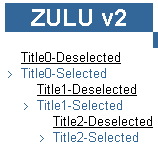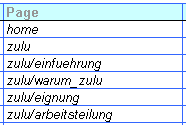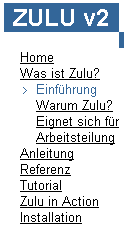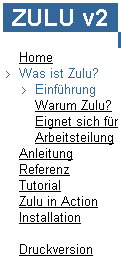
Home
What's Zulu?
Guide
Introduction
Table structure
> Navigation
Site Map
Tips and tricks
Reference
Tutorial
Quickstart
Live Sites
Sample Templates
Installation
Download
Sitemap
Deutsch
English
Webansicht
Navigation
Building a navigation bar
Zulu can build a navigation bar on each webpage. Zulu knows according to the
column Page in the Excel file which webpages exist and how to
arrange them in the navigation bar.

Example: The page "Home" is on the same level as the page "What's Zulu?". The page "Introduction" is a subchapter of chapter "What's Zulu?".
The appearance of the navigation bar such as its font size, spacing etc. is
variable. The layout is defined by the template:

The chapter which is currently selected can be emphasized within the navigation bar. For each hierarchy the template contains a sample of a selected and an unselected entry.
Example template entry: Level 0 selected:
<!--Zulu:Template:Selected:Page:0:Begin-->
<span style="font-family: courier; color: #336699">> </span><span style="font-family: arial; color: #336699"><!--Zulu:Tag:Title--><!--Zulu:Comment:Begin-->Title0-Selected<!--Zulu:Comment:End--></span><br>
<!--Zulu:Template:Selected:Page:0:End-->
Example: Building a navigation bar on the webpage "Why Zulu?":
- Zulu replaces the tag
<!--Zulu:Python:zulu:menu:Page:0:0-->with the navigation bar. - The navigation bar consists of all entries in the column 'Title':

- The arrangement is defined in the column 'Page':
-

- The entry "Why Zulu?" in the navigation bar on the website "Why Zulu?" is
selected. Therefore the entry is formed from the above code-segment. Template
level 0 is selected. The tag
<!--Zulu:Tag:Title-->is replaced by the text in column 'Title': "Why Zulu?". - The completed navigation bar looks like:
-

Show subchapters
With a growing number of entries the navigation bar can become very long. It can be made smaller by only showing subchapters which are within the selected path.
This is done by using the following tag in the template: <!--Zulu:Python:zulu:menu:Page:0:0-->
- The first 0 stands for "open all menus".
- 0: Show only those subchapters which are within the selected path.
- 1: Show all subchapters.
- The second 0 stands for "select parent entries".
- 0: The subordinate chapter is not marked as selected.
- 1: The subordinate chapter is marked as selected.
Example webpage "Introduction": Show only subchapters within the selected path.
<!--Zulu:Python:zulu:menu:Page:0:0-->
 |
Example webpage "Introduction": Show only subchapters within the selected path. The subordinate chapter is marked as well.
This setting is used by the template Nokia.
<!--Zulu:Python:zulu:menu:Page:0:1-->
 |
Example webpage "Introduction": Show all menu entries:
<!--Zulu:Python:zulu:menu:Page:1:0-->
 |
Navigation - Link to an internal page
Most links point to an internal page.
In column "Link" is the text
<!--Zulu:Root-->zulu/eignung/index.html. Zulu replaces the
tag
<!--Zulu:Root--> by adjusting the relative link with respect
to the current page.
Navigation - No page
Normally there is a webpage to each entry in the navigation bar. But it is also possible to define a title without its own webpage but which points to another webpage. This is indicated by a "-" in the column 'Folder' as illustrated by the following example:
The title "What's Zulu" points to the webpage zulu/einfuehrung/index.html.
Therefore the title "What's Zulu?" and "Introduction" point to the same webpage.
Navigation - Link to an external page
Example: The title "Migros" points to www.migros.ch.


